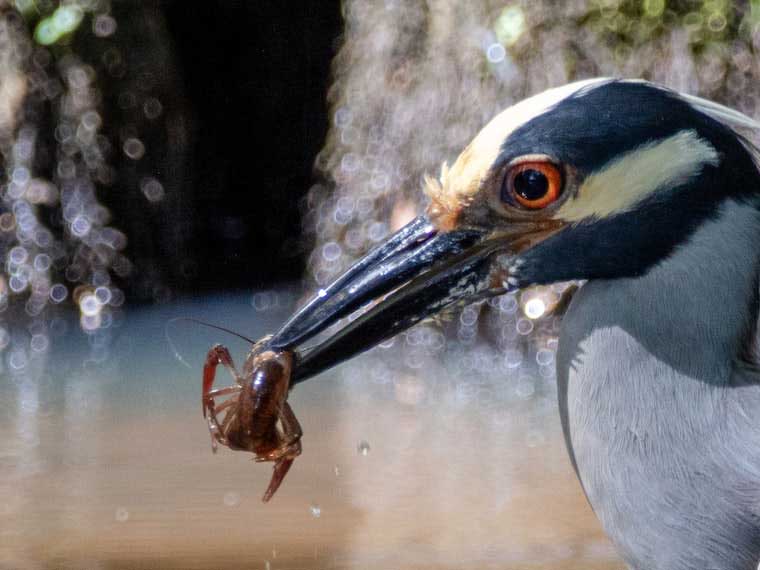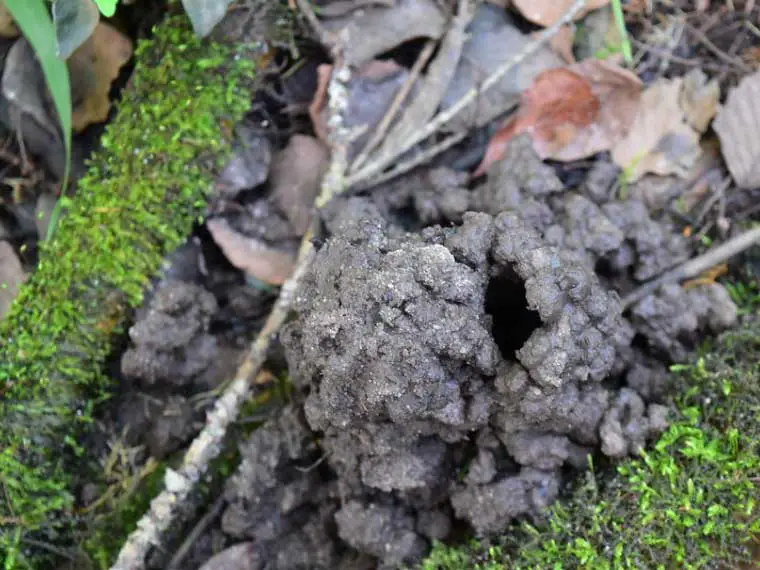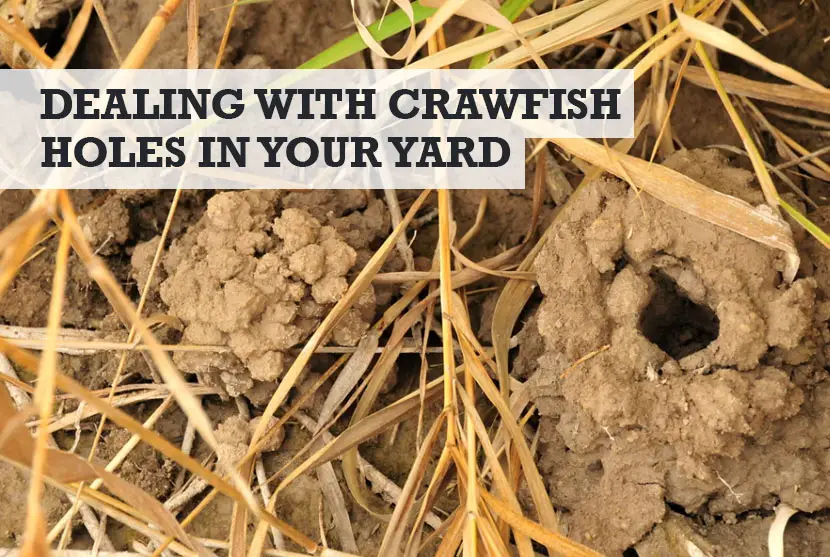If you live near water and have found mounds on the grass of your lawn, there’s every chance these are crawfish chimneys from where holes have been dug. Crawfish, crayfish, or crawdads… call them what you will, they share one trait: they like to dig holes in your yard.
They like to burrow their crawfish holes in yards during rainy seasons. Their perfect habitat is soft and wet ground which is easier to burrow into. Once the crawfish is in the hole in your backyard, they will spend almost all their life down there, away from above ground water.
But in early spring, crawfish will emerge from their holes and burrows to mate, meeting at a stream or water source near your backyard. The females then return to their crawfish holes and burrows where they will rest and eventually lay eggs.

Once the eggs are hatched, the crawfish come out of the ground, and you have more crawfish… meaning more crawfish holes in your yard!
Many readers will want to know how to get rid of crawfish holes in their yard, and I can understand that completely. Whilst crawfish aren’t dangerous, their chimneys can look unsightly, are mowing hazards, and the tunnels and crawfish holes in the grass could collapse.
On the other hand, others take the view that the crawfish holes in their yard and subsequent tunnels can help to aerate the soil, leading to a healthier lawn.
I am not going speculate either way, because this is just about helping you get rid of them and their holes. So, the focus of this guide is how to get rid of the crawfish in your backyard using, mainly, humane methods… but with one “nuclear” option at the end that will kill them.
1. Humane traps that are set near the water source
Get rid of the crawfish, and you get rid of their holes in your yard. But how do you catch crawfish in a yard? Traps, like these on Amazon – but they work best if you place them at the water source during the crawfish mating season.
You fill the traps with chicken bait, then wait for the traps to fill. Once the crawfish are caught, then take them as far away from your property as possible and release back into the wild.
2. Hot chili sauce to get rid of crawfish holes
I know a guy who mixed up hot chili sauce in hot water. He made a very potent mix, knocked the chimney off the crawfish hole, and poured the mix in. He swears blind it makes the crawfish come out of the holes in his yard, at which point he then caught them.
I’ve not tried it, but as far as humane approaches to getting rid of crawfish holes in your yard, it takes some beating if it works.
3. Electronic / ultrasonic critter repellent stakes
You could also look at buying these ultrasonic stakes on Amazon. The premise is quite simple. They push into the ground in your yard by the crawfish holes. The stakes emit a sonic pulse for 4 seconds, every half a minute.
The sonic pulses penetrate the ground in your backyard by the crawfish holes and annoy critters so much they will want to leave eventually. That’s the idea anyway!
4. Biological control of crawfish
If the crawfish are originating from a pond or stream in your backyard, you can use a biological method of control. You will need to introduce predators of crawfish into the water.

This can include sportfish such as trout, bass, catfish, and large bluegills (bream). These fish feast on crawfish and will keep numbers very low, and can get rid of them in a contained water source like pond or lake.
5. Nuclear option: kill the crawfish with Lye
This is not something I would do personally, as I don’t advocate killing them despite how much mess crawfish holes make in your grass. But, from all my research, the best way to get rid of crawfish holes in a yard always seems to come back to this one tip.
You will need buy a bottle of Lye (view on Amazon). It’s a home remedy that is very effective which might surprise you, given it is sold to help unclog drains and used for making soap.
What you do is knock the crawfish chimney mound over, so you then see the hole. Pour a tablespoon of Lye down the hole, possibly pouring a little water too if it doesn’t go all the way in. Be very careful though and wear gloves so to not get it on your skin. It’s very caustic and will burn.
The Lye will seep into the crawfish hole and will kill it. You can then move onto the other holes in your backyard. I don’t believe that Lye will cause long-term damage to the soil, but do check that before you proceed.
FAQs on backyard crawfish holes
How did crawfish get into my yard?
Crawfish get into yards which are near water sources such as streams or low-lying wet areas. They will burrow in your property, and then go back to the nearby stream to breed.
Crawfish might also have been dropped by a predator. Otters, raccoons, mink, and great blue herons all eat crawfish so could have brought them into your backyard.
How deep is a crawfish hole?
Crawfish holes can be as deep as 36 inches, to as shallow as just a few inches. The holes tend to be dug straight down into lawns or sloping banks next to streams and ponds.
Are crawfish bad for your yard?
No, I don’t believe crawfish are that bad for your yard as there is no science or research to show that they damage vegetation and plants. However, many people want to get rid of them due to the aesthetic concerns.
By this I mean the mounds they dig up onto the surface of the grass. Some gardeners hate how this looks and even say it can dull the blades on their mowers when hit.
However, a word of warning comes from The Fish Site:
“At times landowners may be confronted with serious water losses resulting from the sudden collapse or gradual deterioration of earthen pond dams, irrigation canals, and drainage ditches.”
What does a crawfish chimney look like?
I’ve put a photo below of what a crawfish chimney looks like in your backyard. I found a great description too on the Loyola University website:
“Crawfish chimneys are those smokestack-looking things that appear in ditches, fields, and our yards each spring. Everywhere you see one (sometimes a crawfish will make two), there is a crawfish living in a burrow underneath. Their tunnels may extend down into the earth 3 ft or more, sometimes being a single burrow going straight down, but more often being a main tunnel with a couple of side tunnels, each with a room at the end. They are normally full of water.”

Crawfish hole vs snake hole – the differences
Crawfish holes will always have a mound on top, i.e., the chimney I just showed you. Snake holes don’t have this. But that doesn’t mean you won’t find a snake in a crawfish hole.
Crawfish can attract snakes. A snake will kill it, and then can take over the hole as it’s home – here’s how to get rid of snake holes.
And that’s worth mentioning too, as why you might want to get rid of crawfish. Other critters will dig into your lawn to get the crawfish out, creating more problems for keen gardeners.
Handy Hint: Here’s a long guide about snake vs crawfish holes.
How do crayfish dig holes in the ground?
As well know, crayfish do dig holes in the ground, but how are they doing this? It’s because they are burrowers. They dig the soil out straight down or at a very slight angle.
Conclusion
I honestly don’t think you should worry about crawfish holes in your backyard. I’m of the opinion that they will help with drainage. But then, I’ve never really cared about having the perfect lawn – you may well do.
There is no insecticide or pesticide that you can legally use to kill backyard crawfish as it can contaminate ground, so be very careful.
Please do try the humane methods, but in truth, it could be a losing battle you face. There are over 300 different crawfish species in the United States. As example, in Louisiana there are 35 species alone.
More backyard guides…
- Chipmunk holes vs snake holes
- How to get rid of gopher holes in your yard
- What a backyard garter snake hole looks like
Crayfish chimney photo in header by https://flickr.com/photos/51986662@N05/22539466001




